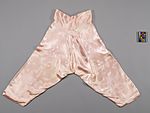baji (Pants)
About this object
History of use
Korean men’s and boys’ traditional trousers have not changed in construction and style from the middle of the Chosun Dynasty until the present. Trousers constructed this way, wide, with a rounded crotch, with no centre seam, and with the legs angled outwards, are comfortable for horseback riding and for working. When worn, the waist is cinched in with a ribbon tie, as are the ankles, which sometimes makes them uncomfortable for children. The cotton lining served to absorb perspiration.
Narrative
Most of the clothing in the J. McRee Elrod Collection was made for him and his family by friends while they were living in Korea, much of it by Kim, Sung Sook. She and her family lived cooperatively in the same house as the Elrod family. While they were there, the Elrods preferred to wear Korean clothing on very cold days and for social occasions. They found it to be more comfortable than western clothing in cold weather, as public buildings were unheated in the period immediately following the Korean War. It also was more comfortable for floor seating in Korean homes, and easier to store with limited furniture than western clothing. The children’s clothing was worn by their children Mark and Lona.
Iconographic meaning
The bat is a symbol of good fortune. The clouds are symbols of long life.
Specific techniques
The trousers were stitched inside out and then reversed through an opening at the top of the waist which was then hand-stitched closed, making all the seams completely invisible. The seam between the legs was sewn last, aligning the two layers carefully. Both the outer and inner layers were constructed of six pieces, which were aligned when assembled.
Physical description
Light pink rayon trousers with white motifs. The trousers have a white straight waistband from which the legs angle outwards. There is a continuous seam on the inner edge of the legs and rounded crotch. There are second seams on the front and back, about one third of the width away from the centre seam. There is an additional seam on the front and back, angling away from the centre of the crotch to the leg seams. Both the outer fabric and lining are constructed in the same way and joined with invisible seams at the edges. The designs on the fabric are floral, butterfly, bat, cloud and circle motifs. The inside lining is unbleached cotton.
Date Made
1955-1960
Date Acquired
13 Oct 1976
How Acquired
Donated
Credit Line
Measurements
82 x 35 cm
Object Number
Ed1.332
